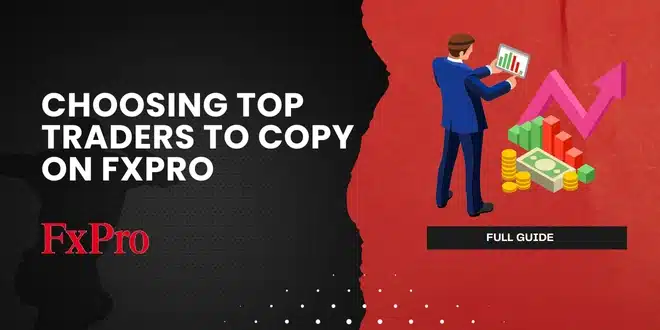Copy trading is an exciting way to access the financial markets—especially if you’re still learning or don’t have time to trade full-time. With FxPro, you can copy experienced traders through cTrader Copy or MetaTrader Signals, two platforms that offer very different experiences.
But how do you know who’s worth copying? This guide breaks down everything from how the platforms work, to what to look for in a top trader, and how to manage your copy trading strategy safely and effectively.
How to Access Copy Trading on FxPro
FxPro does not have an in-house social trading network, but it integrates with two well-known environments:
cTrader Copy
- Built into FxPro’s cTrader platform
- Simple and transparent layout
- Lets you browse verified strategies, see live and historical performance
- Traders can charge performance fees or volume-based commissions
- Features like drawdown stats, strategy descriptions, and live trade logs
MetaTrader Signals
- Part of the MetaTrader 4 and 5 platforms
- Traders offer signals you can subscribe to
- Some are free, others charge a monthly fee
- Performance metrics available, but less transparency
- Signal execution can be delayed due to external hosting
Which one is better?
If you want real-time performance tracking and flexible risk controls, cTrader Copy is more beginner-friendly. If you already use MetaTrader or want access to global signals, MT4/MT5 may work—but with more complexity.
Key Factors to Consider When Selecting Traders to Copy on FxPro
Choosing top traders to copy on FxPro isn’t just about chasing high returns. Here’s what to focus on:
1. Performance History
Look for traders with at least 6–12 months of consistent results. A smooth equity curve (slow, steady growth) is better than huge spikes followed by crashes.
Example: Trader A has returned 6–8% per month over 12 months, with minimal volatility. This shows discipline and consistency.
2. Risk Management
Check the trader’s maximum drawdown and whether they use stop-losses. A lower drawdown (under 20–25%) generally means a more stable strategy.
Example: Trader B made 100% in 3 months but had a 60% drawdown. That’s a red flag unless you’re comfortable with extreme volatility.
3. Trading Style
Pick a style that matches your risk tolerance and time horizon:
- Scalpers: frequent trades, short holding periods, higher noise
- Swing traders: hold trades for several days to weeks
- Position traders: fewer trades, more long-term focus
If you prefer slow and steady growth, avoid scalpers or day traders.
4. Asset Focus
Copy traders may focus on:
- Forex (EUR/USD, GBP/JPY)
- Commodities (Gold, Oil)
- Indices (US500, DAX40)
- Crypto (if supported)
- Choose traders whose markets you understand or want exposure to.
A trader specializing in commodities will likely behave differently than one focused on volatile crypto pairs.
5. Trade Frequency
Review how often the trader opens and closes positions. High-frequency trading may cost more in spreads or fees. Fewer, more thoughtful trades can indicate a more refined strategy.
Tip: Look at average trades per week and win/loss ratio, not just profitability.
6. Transparency and Strategy Description
Traders who share notes, risk profiles, and a clear summary of their strategy are more trustworthy. On cTrader, many traders explain their logic in plain English.
Even if you don’t fully understand their indicators, clear communication shows professionalism.
Realistic Trader Examples
Trader Alpha
- 12-month track record
- 15% total return
- Max drawdown 8%
- Focused on EUR/USD and GBP/JPY
- Uses swing trading strategy
Ideal for cautious investors who want steady growth with low stress.
Trader Flash
- 3-month explosive growth: 75% return
- Max drawdown: 40%
- High trade volume, no stop-losses
- Focused on crypto and exotic forex
High risk/high reward profile. Not recommended for beginners or low-risk tolerance.
Tips for Managing Your Copy Trading Portfolio on FxPro
After you start copying, your strategy still matters. Here’s how to stay in control:
1. Diversify Across Traders
Don’t rely on just one trader. Spread your funds across 2–4 traders with different market focuses or styles. This reduces the risk of any one strategy underperforming.
For example, copy a forex trader, a commodity swing trader, and a low-risk index trader.
2. Start with a Small Allocation
Begin with the minimum amount and scale up once you’re confident. This protects your capital while you learn how each strategy behaves in live market conditions.
Some platforms allow you to set a fixed dollar amount or percentage.
3. Use Risk Limits
Set a maximum allocation per trader, and if supported, a max loss threshold. Never allow one trader to control your full balance.
Good rule: Never give more than 30% of your account to a single strategy.
4. Check Performance Weekly
Keep an eye on:
- Weekly returns
- Open positions
- Drawdown increases
- Changes in strategy
If a trader changes behavior or hits new lows in performance, consider reducing or stopping the copy.
5. Learn From the Traders You Copy
Even if you’re not making decisions yourself, observe how successful traders react to events, use risk controls, and time their entries.
Copying should be part learning, part earning.
6. Use Demo Copying If Offered
If cTrader or your platform supports demo copying, use it to simulate results before putting in real money.
Especially helpful if you’re deciding between several traders and want to compare them.
Common Mistakes to Avoid in Copy Trading
- Chasing high returns only: Fast growth often comes with dangerous drawdowns.
- Copying without reading strategy descriptions: Know what you’re investing in—even if it’s passive.
- Putting all your funds into one trader: Even great traders have bad months.
- Failing to set risk limits: Your capital needs boundaries.
- Ignoring poor performance: If a trader consistently underperforms, it’s time to reassess.
Final Thoughts
Copy trading on FxPro offers beginners and time-limited traders a unique opportunity to leverage the skills of experienced investors. But smart copy trading isn’t passive—it’s informed delegation.
Don’t just copy the trader with the biggest returns. Focus on risk control, consistency, and transparency. And once you’re in, stay engaged. Review performance, set realistic expectations, and adjust your portfolio as needed.
If done well, copy trading can be a powerful learning experience—one that builds your confidence and possibly your returns.
FAQs
1. How do I copy trade on FxPro? You’ll need a cTrader or MetaTrader account. From there, you can access cTrader Copy or MetaTrader Signals and browse available traders.
2. What’s the difference between cTrader Copy and MetaTrader Signals? cTrader Copy offers better transparency, risk controls, and a cleaner interface. MetaTrader Signals connects to a global pool of signal providers but may involve execution delays and less visibility.
3. What’s the minimum to copy a trader? It varies by trader, but many strategies start from $100–$200. Always check the minimum allocation requirement listed.
4. Can I change my allocation or stop copying anytime? Yes. You can stop copying, reduce your capital allocation, or reallocate to a new trader at any time.
5. Are there copy trading fees? Some traders charge a performance fee or commission (shown before you subscribe). FxPro itself does not charge extra for using the copy trading platform.
6. Is copy trading a good idea for beginners? Yes, if approached responsibly. It’s a great way to learn by observing real strategies, but it’s not risk-free. Stay involved and always understand who you’re copying.


